
Winter Festival Hall in Erl by Delugan Meissl
Source
Delugan Meissl
Delugan Meissl
Publisher
Petr Šmídek
06.03.2011 08:30
Petr Šmídek
06.03.2011 08:30
Roman Delugan
Elke Delugan-Meissl
dmaa Delugan Meissl Associated Architects
The winter festival hall’s geometry develops from the surrounding topography and places the building and the already existing summer festival hall in juxtaposition. Its positioning relates to the existing landscape, the dynamic gesture of the historical counterpart, as well as the background rock formations. The buildings face each other, complement and increase the respective constructional articulation of the reference to the landscape and enter an atmospheric interaction. Geometry and colour stress the duality of old and new.
While the existing building comes to the fore during the summer festival period, the change of the seasons causes a reversal in the colours of the ensemble. The building is similar in design to tectonic stratification with interrupting faults whose strategic positioning points the way into the building’s interior. At night, the distinct façade allows insight into the gleaming interior and generates a tantalising entrance into the festival hall’s foyer.
The topographic imprinting in the landscape continues inside the building where two central parameters direct the architectural approach: the interplay between the building’s interior and the surrounding nature as well as the concentrated, spatial composition of a functionally optimised concert hall of international repute. Existing characteristics of the surrounding area are reinforced by the conceptual design. Flowing visual and functional spatial references define the design method: Spaces of different zoning and configurations implement the focus on communication and peace, dynamics and concentration. Architectural conditions in the building’s interior are devolved into a subtle control of the motion sequences through their sensual perception.
The access staircase is integrated into the terrain’s topography and leads visitors into the building’s interior. The cloakroom and reception desk are located close to the entry. The foyer – an asymmetrical space – allows a wide range of impressions of the surrounding natural environment as well as to the existing summer festival hall. In the opposite direction, a staircase leads to the gallery on the level above where the relationship between interior and exterior relations is once again impressively experienced by the extensively glass-fronted western façade. Secondary functions of the building are also located at the upper level. Paths and spatial layout are designed both functionally as well as atmospherically: vast communication zones, narrowing and widening circulation areas and varying ceiling heights translate the tectonic building geometry in a sensually comprehensible way.
Coherently, the approach to the concert hall is effectively emphasised by the gentle rise of the entry level. The concert hall, which is situated at the centre of the building like a shell and is anchored to the rock at the back, is connected to the foyer via two accesses on each level. The passage from the foyer into the concert hall is accompanied by a spatial and atmospheric transformation: Dynamics, variability and asymmetry of the foyer give way to highest concentration, static peace and orthogonality.
Corresponding to the flowing sequence of rooms, the physiological perception of each area is at the centre of the materiality concept. Haptic as well as optical differentiations in the interior follow the building’s functional geometry and contribute to orientation by intuitive allocations of spatial elements and functional areas. The foyer’s bright rays in hibernal twilight emphasises the focus on communication in this space of encounter. Following the metaphor of an excavated jewel, the concert hall offers a change of materials: wooden surfaces and sober colours come together in a warm, atmospheric spatial composition of suspenseful peace and focus the visitors’ concentration and perception on to the performance. Multiple technical fixtures as well as the transformability of the hall allow for manifold uses which go beyond those of a traditional concert and festival establishment.
While the existing building comes to the fore during the summer festival period, the change of the seasons causes a reversal in the colours of the ensemble. The building is similar in design to tectonic stratification with interrupting faults whose strategic positioning points the way into the building’s interior. At night, the distinct façade allows insight into the gleaming interior and generates a tantalising entrance into the festival hall’s foyer.
The topographic imprinting in the landscape continues inside the building where two central parameters direct the architectural approach: the interplay between the building’s interior and the surrounding nature as well as the concentrated, spatial composition of a functionally optimised concert hall of international repute. Existing characteristics of the surrounding area are reinforced by the conceptual design. Flowing visual and functional spatial references define the design method: Spaces of different zoning and configurations implement the focus on communication and peace, dynamics and concentration. Architectural conditions in the building’s interior are devolved into a subtle control of the motion sequences through their sensual perception.
The access staircase is integrated into the terrain’s topography and leads visitors into the building’s interior. The cloakroom and reception desk are located close to the entry. The foyer – an asymmetrical space – allows a wide range of impressions of the surrounding natural environment as well as to the existing summer festival hall. In the opposite direction, a staircase leads to the gallery on the level above where the relationship between interior and exterior relations is once again impressively experienced by the extensively glass-fronted western façade. Secondary functions of the building are also located at the upper level. Paths and spatial layout are designed both functionally as well as atmospherically: vast communication zones, narrowing and widening circulation areas and varying ceiling heights translate the tectonic building geometry in a sensually comprehensible way.
Coherently, the approach to the concert hall is effectively emphasised by the gentle rise of the entry level. The concert hall, which is situated at the centre of the building like a shell and is anchored to the rock at the back, is connected to the foyer via two accesses on each level. The passage from the foyer into the concert hall is accompanied by a spatial and atmospheric transformation: Dynamics, variability and asymmetry of the foyer give way to highest concentration, static peace and orthogonality.
Corresponding to the flowing sequence of rooms, the physiological perception of each area is at the centre of the materiality concept. Haptic as well as optical differentiations in the interior follow the building’s functional geometry and contribute to orientation by intuitive allocations of spatial elements and functional areas. The foyer’s bright rays in hibernal twilight emphasises the focus on communication in this space of encounter. Following the metaphor of an excavated jewel, the concert hall offers a change of materials: wooden surfaces and sober colours come together in a warm, atmospheric spatial composition of suspenseful peace and focus the visitors’ concentration and perception on to the performance. Multiple technical fixtures as well as the transformability of the hall allow for manifold uses which go beyond those of a traditional concert and festival establishment.
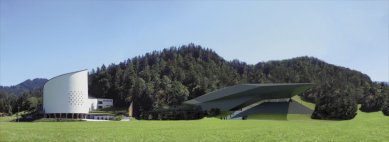
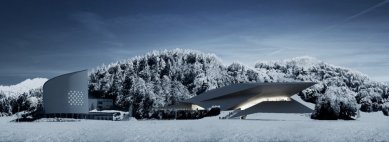


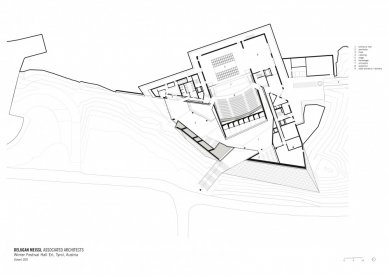
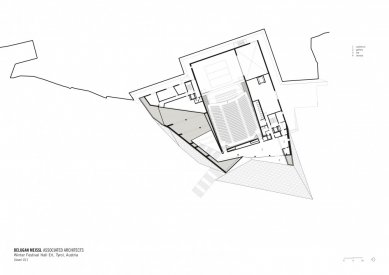

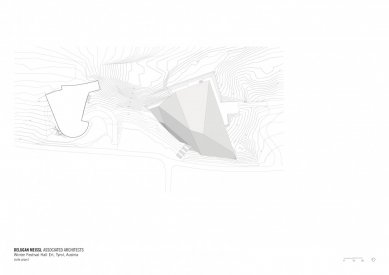
0 comments
add comment












